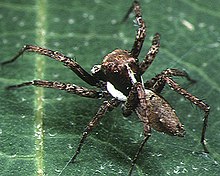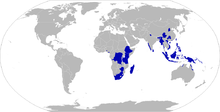Portia (spider)
| Portia | |
|---|---|
 |
|
| Male Portia fimbriata | |
| Scientific classification | |
| Kingdom: | Animalia |
| Phylum: | Arthropoda |
| Subphylum: | Chelicerata |
| Class: | Arachnida |
| Order: | Araneae |
| Infraorder: | Araneomorphae |
| Family: | Salticidae |
| Genus: |
Portia Karsch, 1878 |
| Type species | |
|
Salticus fimbriatus Doleschall, 1859 |
|
| Species | |
|
See text |
|
| Diversity | |
| 17 species | |
 |
|
|
|
See text
Portia is a genus of jumping spider that feeds on other spiders (araneophagic). They are remarkable for their intelligent hunting behaviour, which suggests that they are capable of learning and problem solving, traits normally attributed to much larger animals.
The genus was established in 1878 by German arachnologist Friedrich Karsch. The fringed jumping spider (Portia fimbriata) is the type species.
Molecular phylogeny, a technique that compares the DNA of organisms to construct the tree of life, indicates that Portia is a member of a basal clade (i.e. quite similar to the ancestors of all jumping spiders), and that the Spartaeus, Phaeacius, and Holcolaetis genera are its closest relatives.
Wanless divided the genus Portia into two species groups: the schultzi group, in which males' palps have a fixed tibial apophysis; and the kenti group, in which the apophysis of each palp in the males has a joint separated by a membrane. The schultzi group includes P. schultzi, P. africana, P. fimbriata, and P. labiata.
At least some species of Portia are in the state of reproductive isolation: in a laboratory, male P. africana copulated with female P. labiata but no eggs were laid; during all cases the female P. labiata twisted and lunged in an attempt to bite.
Some specimens found trapped in Oligocene amber were identified as related to Portia.
The 17 described species are found in Africa, Australia, China, Madagascar, Malaysia, Myanmar, Nepal, India, the Philippines, Sri Lanka, Taiwan, and Vietnam.
...
Wikipedia
